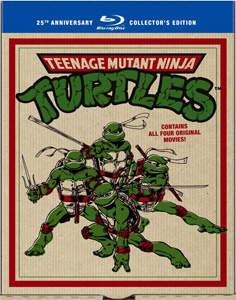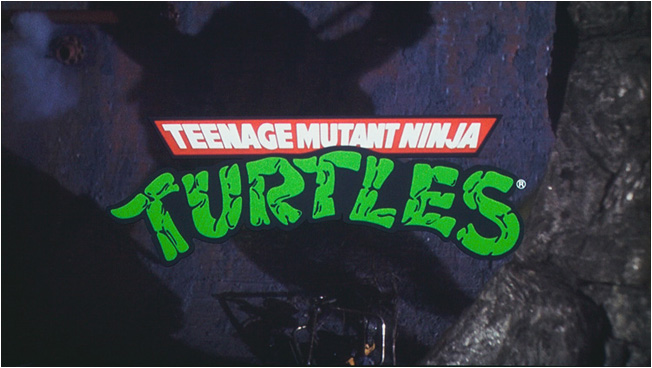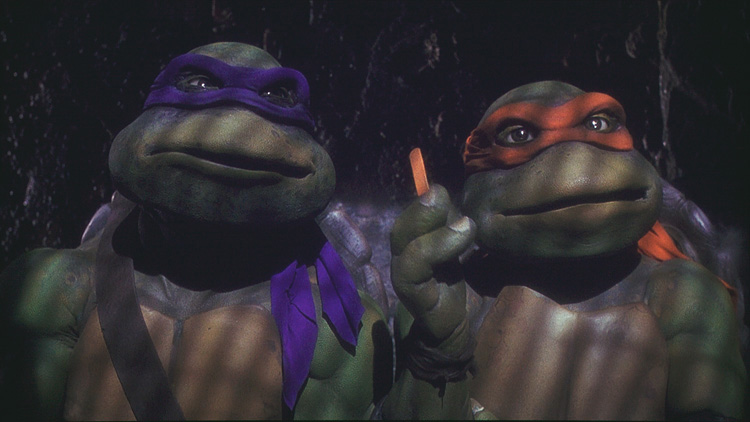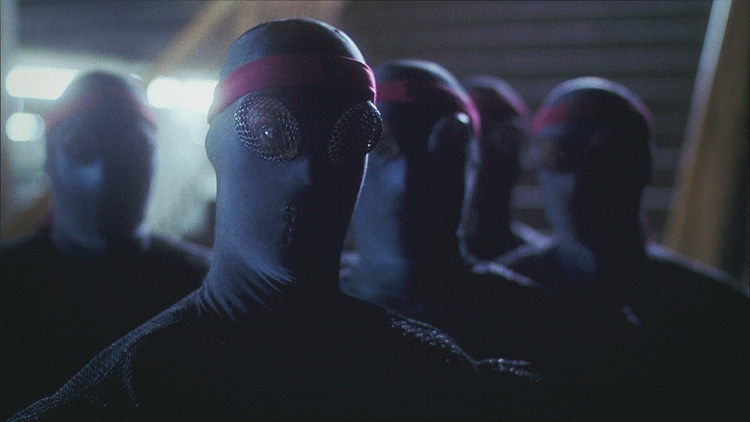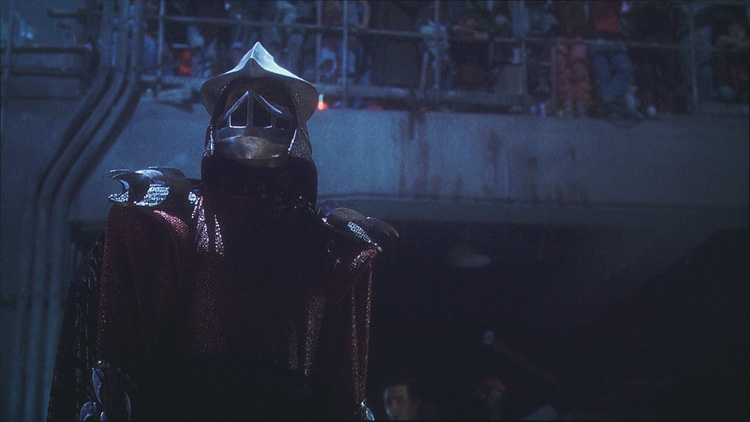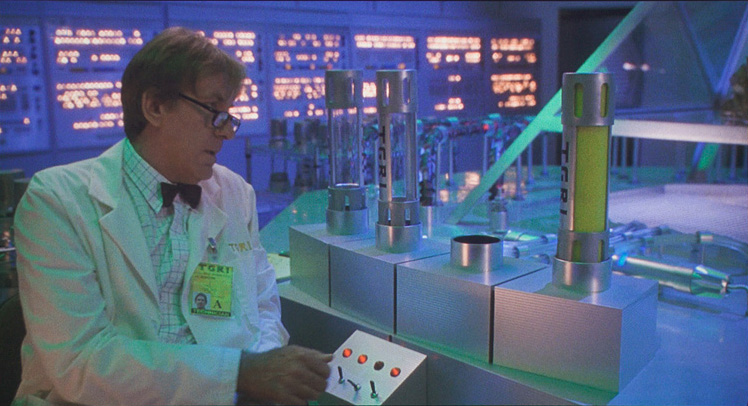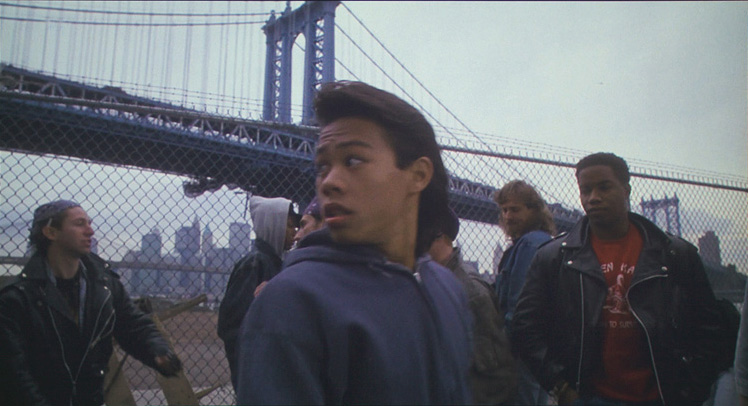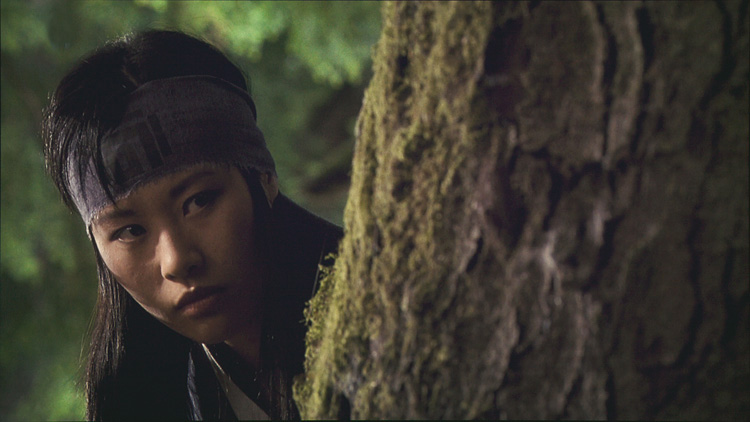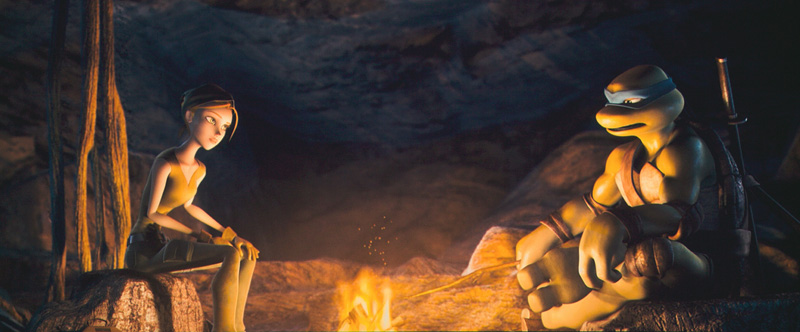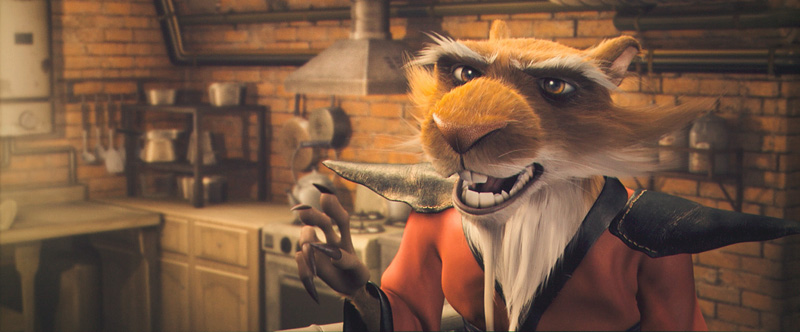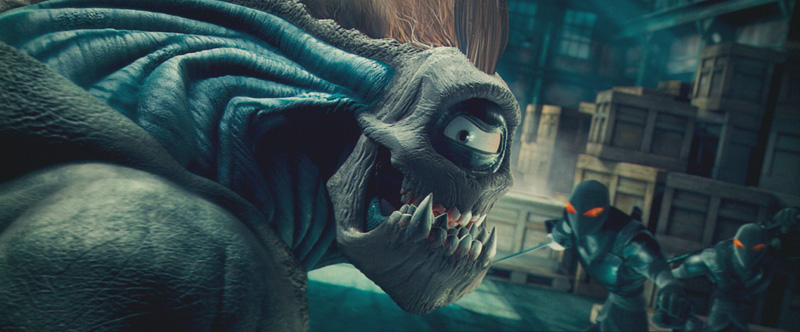Extras:
• Inserts: Comic Book, Signed Sketch, Radical Beanie,
Character Cards
• Theatrical Trailers in HD w/ low bit rates
• TMNT: Commentary by Director/Writer Kevin Munroe
• TMNT: 7 Behind the Story Featurettes
• TMNT: Alternate Opening, Ending & Additional Scene
• Preview of Smash-Up Video Game
The Film:
Through the 1980s, along with the rise of the arcade video
game and home versions like the Atari 2600, kids would get
their kicks from comic books, toys and made for TV cartoon
series. Teenage Mutant Ninja Turtles, originally designed as
a parody of superhero comics, was to become a marketing
phenomenon, taking hold of preteen boys by storm. It was
only a matter of time before it would find its way onto the
big screen.
|
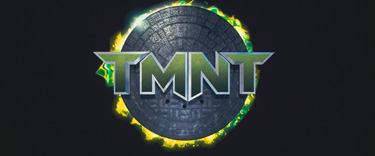 |
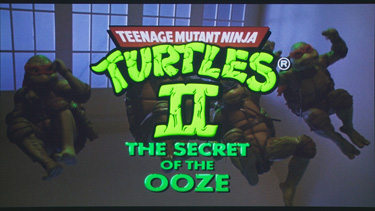 |
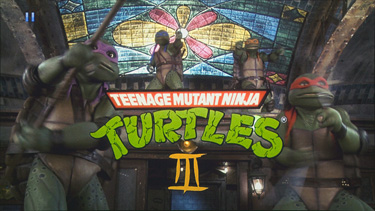 |
And so it did in 1990, and again in 1991 and again in 1993.
Kids would continue to eat up each successive permutation,
but the storylines and dialogue - if they can so be called –
were getting more difficult for parents and movie buffs to
swallow.
If you don’t already know – and it is possible that you
missed that window of opportunity – the movie is set in
Manhattan, as were the original comics, with the turtles
already in their teenage prime taking on thieves and
muggers. How could this be, you might well ask! The movie
explains in flashback how “Splinter” the rat was once the
pet of a master ninja. Splinter passes the hours mimicking
the ninja moves of his master until killed by Oroku Saki in
a jealous rage (the master, not the rat). Making his way to
Big Apple sewer system, Splinter and a few hapless, young
turtles are exposed to a radioactive substance which, in
very short order, promote rapid growth and the ability to
speak, with English of a sort their language of choice.
Hiding out in the sewers, Master Splinter takes advantage of
his new role as mentor to the turtles and teaches them a
code and ninja skills. The turtles he names for famous
painters of the Renaissance – just another expression of the
rat’s lofty ideals – Leonardo, Rafael, Michelangelo and
Donatello, each distinguished by the color of their
bandanna, preferred weapon and personality traits. Being
teenagers now, they watch a great deal of television in
their sewer living room and have picked up a few timely
exclamations, like “Dude” and “Cowabunga.” They also have a
passion for pizza, which they order out, a lot.
The first movie has them battling an organization of thieves
led by “The Shredder.” There is something uncomfortably
reminiscent of our own Aryan Nation about Shredder’s
operation, as he feeds on the general alienation of human
teenagers to get them to do his bidding. The odds are
clearly not in the Turtles’ favor, especially once Splinter
is captured. The turtles, for their part, have come out, so
to speak, at least to one human (Judith Hoag), a journalist
who is rescued from thugs by Rafael one night. Her boss’s
son has been recently induced by the dark side, making it
all the harder for good to triumph.
In the first sequel, our superhero turtles return, now with
a new friend, Keno (Ernie Reyes, Jr.) Judith Hoag, who
played April O'Neil, the journalist and buddy of the
Turtles, is replaced by daytime soap star Paige Turco. Paige
is prettier with plenty of positive energy, but I missed
Judith, who was spunkier and more grounded and, if this
makes any sense, more believable and balanced as the fulcrum
for the turtles. Their enemy, The Shredder (Francois Chau,
channeling Darth Vadar), arises from the trash heap to
rejoin the relentlessly grunting Tatsu (Toshiro Obata) and
his hooded Foot Gang to make things difficult for mankind
and the turtles. David Warner adds a few comic touches as a
toxic waste scientist – you know: the guy who explains
things in radioactive monster movies. Vanilla Ice raps a
little – good career move.
In Teenage Mutant Ninja Turtles III, first April, and then
the Turtles in pursuit, are transported back to feudal
Japan, where they get involved in a conflict between
warlords and rebels. Elias Koteas reprises his role form the
first movie as Casey Jones, appearing in both the present
and the past in different roles, making for the one bright
spot in an otherwise shoddy movie.
TMNT differs from the preceding three movies in this
collection in that it is entirely CGI. The timeline picks up
more or less where the previous movie left off, and finds
the turtles in a state of semi-diaspora. The basic plot has
to do with an ancient legend that began 3000 years ago to
capture alien beasts and statues of his erstwhile generals.
Tensions mount as the turtles attempt to reconnect and sort
out their leadership difficulties. The Foot Clan reappear
led by Karai (voiced by Zhang Ziyi).
The Movies: 6/4/3/7
There is something utterly charming about the absurd sight
of humans wearing turtle shells held on by a belt and
colorful bandanna-like masks, presumably to protect their
identities like The Lone Ranger, scarfing down pizza, making
ninja moves on their opponents. The first sequel is less
concerned with Yoda-like mentoring and more with wisecracks
which the turtles make with just before kicking the various
ass adversaries.
Unhappily, as the franchise began to take itself seriously,
what charm there was gave way to mindless repetition,
especially by the third movie. What was once fresh got stale
quickly. Kids, so I’m told, required no such critical sense.
On the other hand, TMNT is a different matter altogether.
The target audience is older and with that comes a darker
story, with more ambiguous characters. The animation is
quite good and character design inventive.
Image:
3~8/5~9
The first number indicates a relative level of excellence
compared to other Blu-ray video discs on a ten-point scale.
The second number places this image along the full range of
DVD and Blu-ray discs.
Few things are exasperating in this world of hi-def
transfers than to see the less good movies receive better
marks than better movies. This is generally the “fault” of
the source materials, and such is more or less the case
here. The first movie is decent; the second, much less so;
the third, more highly resolved but oddly lit; and the
fourth, very good, indeed.
A good deal of the first movie takes place in the darkness
of the sewers and the dimly lit salons where Splinter and
the turtles hide out. The turtles are generally nocturnal,
so their forays into the city tend be at night as well. The
first movie puts the noise issue to the test, and the
results are, well, variable at best. Mostly, the image is
simply thin and grainy. I can't say I was distracted by
artifacts or other problems since the murkiness of the image
took precedence. Your average decently produced DVD will
look better. I didn't notice print damage, so there might
have been some clean-up at work there. It is entirely
possible this movie, and the first sequel – which looks a
lot like the first, only worse – represent what we would
have seen theatrically almost 20 years ago.
The third movie is a different kettle of worms in that the
lighting is unnaturally applied so that the turtles pop out
of the frame more. Indeed, color, contrast, and resolution
are much better – but the results are so plastic and
cartoony that the upgrade in image is entirely undone by
production values.
TMNT looks good and, no doubt, could have looked better
still if the bit rates were higher. When I would check, they
seemed to collect around 10 Mbps. Pretty bad.
Audio & Music:
5<7/4<7
There's not much to be gained for the uncompressed audio mix
for the first three movies. The situation is better for TMNT,
no surprise there. For the live action movies, dialogue
tends to be flat and thick, the music opens things up a bit.
Surround effects are minimal, but add a touch of space to
the proceedings. Again, the animated film is much better.
Operations:
2
First a word about the box design which, except for the
shape, is supposed to put us in mind of a pizza box. We can
be thankful that [a] it is not shaped like a pizza delivery
box and [b] that it isn’t as flimsy. But it almost is. The
box wouldn’t seem so flimsy if it didn’t have so much space
in it for all the inserts to fit snuggly within. But once
removed – and they will be removed – what’s left is a
two-inch empty space with 2 discs atop one another fixed to
the inside top and bottom cover. This invites disaster. A
pizza box is starting to look pretty good right about now.
The scene selection menu is unfinished in that, even though
individual chapters are thumbnails, they cannot be selected.
Instead, one has to count clicks for each group of five
scenes, and you still might get it wrong.
Extras:
3
Until TMNT, the extra features are pretty much limited to
the knick-knacks inside the box and theatrical trailers for
each movie. Among those bits is a superb, if way too small,
65-page glossy comic book based on the movies. TMNT has
quite assortment of Behind the Scenes featurettes, which I
did not preview in any depth, but they seemed to have
promise.
|
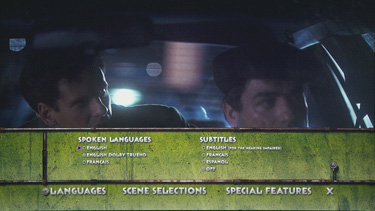 |
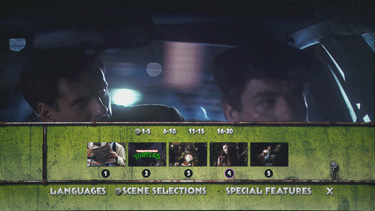 |
|
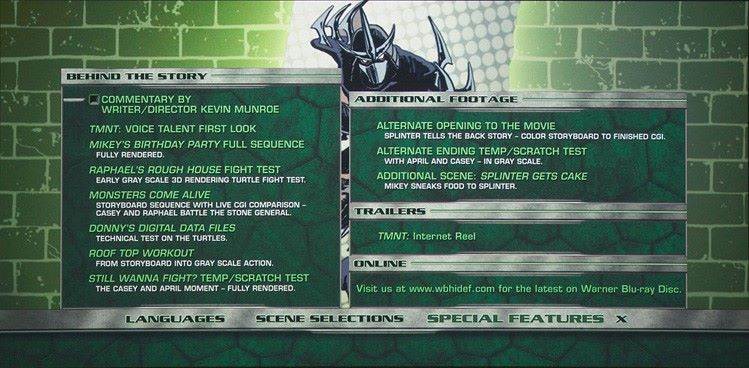 |
Bottom line:
5
So here’s the rub: Who’s the target audience for these
movies now: the original audience, now 15 years older, or
freshly minted youngsters? Would the first group spring for
the hefty purchase price of this set just to see how silly
they once were to eat this stuff up? A rental, absolutely,
but actually buy it? And the second group: I worry they
might be too sophisticated nowadays. But if not, the new DVD
at a much lower price should suffice since I can’t imagine
mom and dad glued to their seats in rabid fascination.
Rather they would more likely become collateral damage as
their brains are slowly degenerated into mush. Except for
TMNT, none of these movies come remotely close to demo
material.
Leonard Norwitz
August 8th, 2009
![]()
![]()

![]()
![]()
![]()
![]()

![]()
![]()
